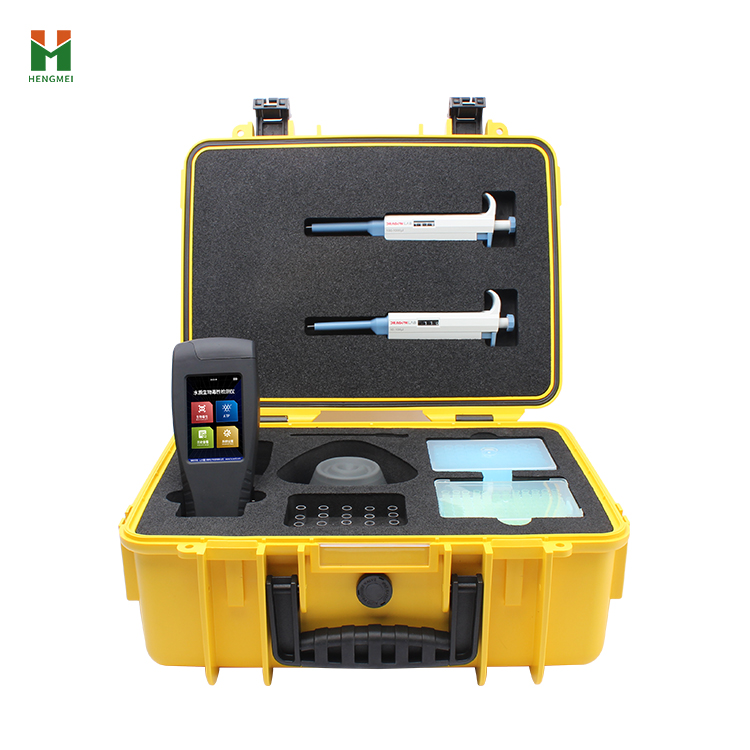Handheld Biological Toxicity Detector: Principles and Applications in Environmental Monitoring
Article Source: Hengmei Technology Release time:2025-10-20 17:51:58
From drinking water safety to industrial wastewater discharge, from soil pollution monitoring to marine ecological protection, every aspect relies on accurate detection of biological toxicity. Handheld biological toxicity detectors, with their high efficiency, sensitivity, and portability, have become a crucial tool in environmental monitoring.

I. Handheld Biological Toxicity Detectors: Technical Principles and Core Advantages
(I) Technical Principle
The handheld biological toxicity detector is based on bioluminescent sensing technology, utilizing naturally occurring luminescent bacteria (such as Photobacterium luminescens and Vibrio fischeri) as biosensors. These bacteria emit light of specific wavelengths during their normal metabolism. When exposed to toxic substances, their cellular respiration is hindered, resulting in a decrease in luminescence intensity. By precisely measuring changes in luminescence intensity, the instrument can rapidly assess the overall toxicity level of a water sample and perform qualitative and quantitative detection of a variety of toxic substances, including heavy metals, poisons, and pesticides.
(II) Core Advantages
1. High Efficiency and Speed: Test results are available within 15 minutes of sample preparation, far exceeding traditional biological testing methods and providing valuable time for emergency response.
2. High Sensitivity: Utilizing a silicon photomultiplier tube (SiPM) detector, this significantly enhances detection sensitivity, demonstrating high sensitivity to over 3,000 toxic compounds.
3. Portable and Easy to Use: Its lightweight, handheld design makes it easy to operate on-site. Its Android operating system provides a user-friendly interface and simple operation.
4. Multifunctionality: In addition to toxicity testing, it also features ATP detection, enabling simultaneous assessment of microbial contamination levels, enhancing the comprehensiveness and accuracy of testing.
5. Data Connectivity: Supports Wi-Fi, mobile hotspot connectivity, and Bluetooth transmission, enabling real-time data upload and sharing, meeting regulatory requirements for real-time data.
II. Application Areas: Comprehensively Protecting Ecological Security
The handheld biotoxicity detector has a wide range of applications, including drinking water testing, emergency response (biological contamination, toxic chemical leaks), municipal drainage, rainwater testing, drilling fluid and mud testing, mining wastewater treatment, industrial wastewater discharge monitoring, seawater testing, medical/pharmaceutical product testing, food packaging testing, and testing of personal care products and household chemicals. Its rapid and accurate detection capabilities provide strong technical support for various industries, effectively ensuring water quality safety and ecological balance.
III. Parameter Indicators: Demonstration of Technical Strength
The handheld biotoxicity detector also excels in technical parameters. Its diverse measurement modes, including rapid, basic, and ATP, meet the needs of diverse testing scenarios. The detector utilizes a silicon photomultiplier tube (SiPM) with a spectral range of 300-1100 nm, ensuring comprehensive and accurate detection. Its ATP sensitivity reaches 10-15 to 10-18 mol, enabling precise detection of microbial contamination. Furthermore, the instrument boasts high sensitivity, high repeatability, and low linearity error, ensuring the reliability and stability of test results.
IV. Application Cases: Performance in Real-World Scenarios
(I) Drinking Water Safety Monitoring
At a city's drinking water source, the environmental protection department uses a handheld biotoxicity detector for regular testing of source water. Through rapid screening, multiple potential contamination incidents have been promptly identified and addressed, effectively ensuring the safety of drinking water for citizens.
(2) Industrial Wastewater Discharge Regulation
The wastewater discharged by a chemical company contained multiple toxic substances, posing a serious threat to the surrounding environment. Environmental protection authorities used a handheld biotoxicity detector to monitor the company's wastewater in real time. Once excessive discharge was detected, immediate action was taken, effectively curbing the spread of pollution.
(3) Marine Ecological Protection
During offshore oil exploration and development, leakage of drilling fluid and mud has a serious impact on marine ecology. A marine research institute uses a handheld biotoxicity detector to rapidly test marine water quality, providing strong support for marine ecological protection.
As an innovator in environmental monitoring, handheld biological toxicity detectors, with their high efficiency, sensitivity, and portability, provide strong assurance for water quality safety and ecological balance.
Address of this article:https://www.kjhm.net/news/788.html
 Related News
Related News
-
19 / 2024-12
High-precision infrared oil detector: an important tool to improve the efficiency of water quality detection.
Learn more
-
29 / 2025-09
How Soybean Protein Analyzers Achieve Rapid Multi-Index Detection?
Learn more
-
16 / 2025-09
Total Phosphorus Analyzer: Essential for Water Quality and Environmental Monitoring
Learn more
-
11 / 2024-05
Photosynthesis meter: Revealing the mysteries of plant growth.
Learn more



 Current
Location:
Current
Location:





